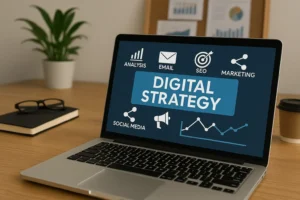In an era where digital dominates consumer habits, implementing digital marketing has ceased to be an option and has become an urgent necessity. Now more than ever, brands need to connect with their audiences through digital channels, using strategies that really work.
In this article, we'll guide you step-by-step through the essential steps for an effective implementation. From market analysis to continuous optimization, you'll learn how to structure and execute a solid plan aligned with your business objectives.
Phase 1: Market Research and Analysis
Every digital marketing implementation project must begin with a rigorous research phase. You can't optimize what you don't understand, and knowing your audience and environment is key to making sound decisions.
What does market research entail?
- Target audience analysis: Segment your audience and define your buyer personas. Use surveys, interviews, tools like Google Analytics, or even social platforms to detect patterns of behavior, interests, and pain points.
- Competitive Benchmarking: Observe your competitors. What type of content do they publish? How do they manage their social media presence? What keywords do they rank for? Tools like SEMrush or SimilarWeb can help you gather useful data.
Objective of this phase: Build a solid knowledge base to design strategies that respond to real needs. Want to delve deeper into the importance of market research? Discover how this analysis can make a difference in your results by reading our article: “Why is it Important to Conduct Market Research in Digital Marketing?”
Phase 2: Definition of Objectives and KPIs
A successful digital marketing implementation requires direction. And that's achieved by setting clear, measurable, and achievable goals.
How to define your goals
Use the SMART methodology:
- Specifics: What do you want to achieve?
- Measurable: How will you know if you succeeded?
- Achievable: Is it realistic?
- Relevant: Does it contribute to the business?
- Temporary: In how much time?
Example: “Increase web traffic by 30% in 6 months through SEO content and ad campaigns.”
Define your indicators (KPIs)
Some key KPIs for digital marketing include:
- Organic web traffic
- Conversion rate
- CPC (cost per click)
- ROI (return on investment)
- Average time on site
Objective of this phase: Accurately measure results to optimize your strategic decisions.
Phase 3: Content Creation and Optimization
Content is the cornerstone of any digital marketing implementation. It attracts, informs, persuades, and converts. But not just any content: it must be strategic, valuable, and SEO-optimized.
How to create content that works?
- Research relevant keywords: Use tools like Google Keyword Planner, Ubersuggest or AnswerThePublic to find terms that your audience is actually searching for.
- Define strategic formats: Blogs, videos, reels, infographics, guides… choose formats based on your audience and goals.
- Optimize for search engines: Include keywords naturally, work on headings, meta tags, and internal links.
Objective of this phase: Position yourself in search engines and provide useful content that strengthens your digital authority.
Phase 4: Implementation of Digital Strategies
Once you have the analysis, objectives, and content, it's time to execute. This is where digital marketing implementation takes shape through various channels and tactics.
Key channels to activate:
- Google Ads: A well-structured campaign can deliver immediate results. Be sure to use:
- Relevant and segmented keywords
- Clear and persuasive ads
- Landing pages optimized for conversions
- Social networks: Choose the platforms where your audience is located (Instagram, Facebook, LinkedIn, TikTok). Create personalized content, leverage native formats (stories, reels, carousels), and maintain a consistent frequency.
- Email marketing: Don't underestimate the power of email. A good email marketing system allows you to segment audiences, automate messages, and maintain long-term engagement.
Objective of this phase: Take your strategy from paper to action, using the right channels to maximize reach and conversions.
Phase 5: Continuous Measurement and Optimization
The digital marketing It's not static. Every action must be measured and adjusted. This final phase is critical for a truly effective digital marketing implementation.
How to measure and optimize?
- Analyze performance: Use Google Analytics, Search Console, social media metrics, and automation tools to understand what's working.
- Perform A/B testing: Experiment with different formats, copy, email subject lines, and landing pages. This allows you to make decisions based on real data.
- Adjust your strategy: If something isn't working, change it. Digital marketing is all about continuous improvement.
Objective of this phase: Learn from your data and apply constant improvements to maximize results.
Your Digital Marketing Implementation Starts Today
Implementing a successful digital marketing strategy isn't a one-day task. It requires planning, analysis, strategic execution, and constant optimization. But the results—increased visibility, improved conversions, sustained growth—are worth it.
At At Agencia RocoWe help companies like yours design and implement effective, customized digital strategies focused on real results. Ready to take your business to the next level? Start working on your digital strategy today or contact us for advice.









